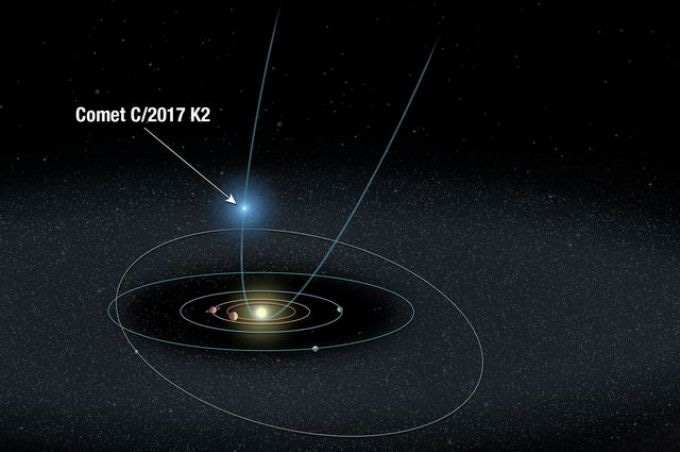Oct 6 2017
An Astronomers group headed by David Jewitt, a UCLA Professor, has recognized a “special comet” 1.5 billion miles away from sun. To date, no comet traveling toward the sun has been observed at such a distance.
 The orbit of comet K2, which has been traveling for millions of years from its home in the frigid outer reaches of the solar system and is currently beyond Saturn’s orbit. Credit: NASA, ESA and A. Field/STScI
The orbit of comet K2, which has been traveling for millions of years from its home in the frigid outer reaches of the solar system and is currently beyond Saturn’s orbit. Credit: NASA, ESA and A. Field/STScI
According to Jewitt, the finding will allow Astronomers to observe the developing activity of a comet across an exceptional range of distances.
C/2017 K2 (PANSTARRS), or K2 in short, is at present positioned beyond Saturn’s orbit. It has been moving for millions of years from its origin in the freezing outer stretches of the solar system, where the temperature is nearly 440° below 0 °F. The comet was captured on camera by NASA’s Hubble Space Telescope, and the observations of the team have been published in the Astrophysical Journal Letters.
The orbit of K2 shows that it has traveled from the Oort Cloud, a huge spherical region perceived to include hundreds of billions of comets.
K2 has been moderately warmed by the faraway sun, and has started to form a fuzzy dust cloud with a width of 80,000 miles, known as coma. The dust cloud includes a small, solid nucleus made of dust and frozen gas. The recent surveys portray the early indications of activity observed till date from a comet approaching the planetary zone of our solar system for the first time, such as K2.
Because K2 is so far from the sun and so cold, water ice there is frozen like a rock, and we know for sure that the activity—all of the fuzzy stuff making it look like a comet—is not produced by the evaporation of water ice, as it is in other comets.
Professor David Jewitt, Planetary Science and Astronomy, UCLA
He further stated that the comet gets more warmed when it gets nearer to sun.
According to Jewitt, the Hubble’s observations of the coma of K2 indicate that sunlight heats frozen volatile gases (e.g. carbon monoxide, nitrogen, oxygen and carbon dioxide) covering frigid surface of the comet, and also that the coma is formed when the icy volatiles are lifted off from the comet and release dust.
“I think these volatiles are spread all through K2,” stated Jewitt. “But the volatiles on the surface are the ones that absorb the heat from the sun, so, in a sense, the comet is shedding its outer skin.”
According to Jewitt, a majority of comets are observed much closer to the sun (i.e. closer to Jupiter’s orbit); therefore, the volatile gases on the surface of the comet are already “baked off” when the Astronomers view them. “That’s why I think K2 is the most primitive comet we’ve seen.”
Astronomers discovered K2 in May by adopting the Panoramic Survey Telescope and Rapid Response System (Pan-STARRS), a survey telescope positioned in Hawaii, a survey project of NASA’s Near-Earth Object Observations Program. Jewitt obtained a closer view of the comet in June by using Hubble’s Wide Field Camera 3, enabling him to ascertain the width of the coma and allowed him to roughly calculate the size of the nucleus (which is less than 12 miles), even when the diameter of the coma is nearly 10 times the diameter of Earth.
Once the Astronomers observed K2 in the Hubble images, they were aware of the fact that the comet and its fuzzy coma were in fact photographed earlier, in 2013 by Hawaii’s Canada–France–Hawaii Telescope (CFHT). UCLA Graduate Student Man-To Hui recognized K2 in data acquired from the CFHT while analyzing images in a Canadian archive. However, it was could be barely viewed that it was not observed upon initially analyzing the photos.
A fascinating feature noticed in Hubble’s K2 images was the non-existence of a “tail,” which is a trademark aspect of comets. The Astronomers noted in their paper that this denotes that particles baked off from the comet are so huge that they are not swept back to form a tail due to the radiation pressure from the sun.
It should become more and more active as it nears the sun and presumably will form a tail.
Professor David Jewitt, Planetary Science and Astronomy, UCLA
The comet will reach very close to the sun in the year 2022 when it passes just farther from the orbit of Mars.